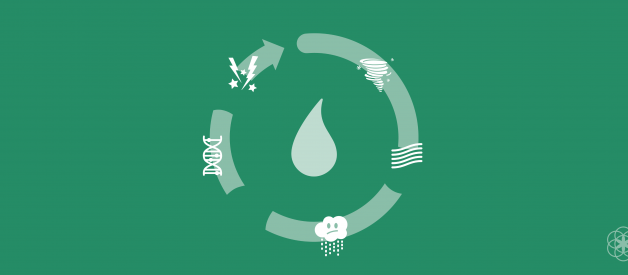By Maegan Boutot, Science Writer for Clue

Miscarriage, or the loss of a pregnancy in the first 20 weeks, is a very common experience, especially within the first 13 weeks of a pregnancy (1). At least 1 in 3 pregnancies will end in a miscarriage, though people do not always know that they were pregnant when a miscarriage occurs (1,2). Miscarriages are also most common in the first six weeks of pregnancy (3).
When a miscarriage occurs very early in pregnancy (for example, less than or equal to two weeks after an expected period), it can be difficult to tell the difference between a normal menstrual period and miscarriage, especially if a person occasionally or regularly experiences heavy or painful periods. Symptoms of both menstrual periods and miscarriage can include heavy bleeding, pain, and cramping (1, 4?10). If a person doesn?t know they are pregnant, and has a miscarriage around the time of an expected period, they will probably assume they are having a period as usual (5).
People who miscarry this early (i.e. less than or equal to two weeks after an expected period) are highly unlikely to experience complications with the miscarriage process (5). Complications in miscarriage are far more common in later miscarriages, after about 12 weeks, when there is more fetal development (11).
The later into a pregnancy a miscarriage occurs, the more it will differ from a menstrual period. Bleeding from later miscarriage will contain fetal tissue, and blood clots will likely be larger than during normal menstrual periods. The tissue will likely look different from menstrual blood in color (ex. gray), consistency/texture, and shape.
Although early miscarriages don?t represent a threat to a person?s health, people may be concerned about early miscarriages as it relates to their chance to have healthy pregnancies in the future. Because early miscarriages happen quite frequently and many people who experience an early miscarriage don?t know they miscarried at all, it is unlikely that a single early miscarriage occurring before it?s even detected has much implication for long-term fertility (1,2). Also, many people who miscarry, even later into pregnancy and multiple times, can go on to have healthy pregnancies in the future (12).
If you?re nervous that you might be pregnant and want to know if your bleeding is a miscarriage or a normal period, you should take a pregnancy test or visit your healthcare provider.
If you?re unsure if you should take a pregnancy test, consider your risk of pregnancy:
- If you have a regular menstrual cycle (for example, your cycle length rarely varies by more than a couple days), then you are only at risk of pregnancy if you had unprotected heterosexual sex or had a high risk of sperm touching your genitals during your fertile window. This is the six days leading up to and including ovulation, usually around the middle of your cycle (note that the fertile window displayed in Clue is only an estimate ? your actual fertile window might have different timing, which can vary cycle-to-cycle along with the start date of your period). You can take a pregnancy test about two weeks after your estimated ovulation day, but the earlier you take a test the less accurate it may be and some brands are more sensitive than others (13). You should probably take a pregnancy test or contact your healthcare provider if your period is nine or more days late.
- If you have an irregular cycle (i.e. you don?t know when your period is going to come and the difference between your longest cycle and shortest cycle is more than 7?9 days), then unprotected sex or exposure of sperm on your genitals at most times represents a risk. You can take a pregnancy test about two weeks after your last unprotected sexual encounter, though the earlier you take a test the less accurate it may be and some brands are more sensitive than others (13).
(Remember, any form of unprotected sex at any time represents a risk of sexually transmitted infections.)
If you know you are pregnant and begin bleeding, it is important to contact your healthcare provider. Bleeding during early pregnancy is common and isn?t necessarily a sign of a miscarriage, but it?s good to let them know what?s going on (14).
If you experience abnormal bleeding, severe pain from your pelvis to your shoulders, and are feeling weak or are fainting, you should seek medical care immediately (15). These could be signs of an ectopic pregnancy (when a fertilized egg attaches and grows somewhere other than the uterus, most commonly in the fallopian tube) (15). Ectopic pregnancies are life-threatening and should be treated as medical emergencies.
Clue can help you track your menstrual cycles, sexual activity, and changes in your emotional and physical status to help you figure out if something is off or if everything is how it should be. Download Clue today for iOS and Android.
References
1. Griebel CP, Halvorsen J, Golemon TB, Day AA. Management of spontaneous abortion. Am Fam Physician. 2005 Oct 1;72(7):1243?50.
2. Wilcox AJ, Weinberg CR, O?Connor JF, Baird DD, Schlatterer JP, Canfield RE, Armstrong EG, Nisula BC. Incidence of early loss of pregnancy. New England Journal of Medicine. 1988 Jul 28;319(4):189?94.
3. Tong S, Kaur A, Walker SP, Bryant V, Onwude JL, Permezel M. Miscarriage risk for asymptomatic women after a normal first-trimester prenatal visit. Obstetrics & Gynecology. 2008 Mar 1;111(3):710?4.
4. American College of Obstetricians and Gynecologists. Practice bulletin: early pregnancy loss. 2015. Retrieved from https://www.acog.org/-/media/Practice-Bulletins/Committee-on-Practice-Bulletins—-Gynecology/Public/pb150.pdf
5. Promislow JH, Baird DD, Wilcox AJ, Weinberg CR. Bleeding following pregnancy loss before 6 weeks? gestation. Human Reproduction. 2007 Mar 1;22(3):853?7.
6. Ellish NJ, Saboda K, O?Connor J, Nasca PC, Stanek EJ, Boyle C. A prospective study of early pregnancy loss. Human Reproduction. 1996 Feb 1;11(2):406?12.
7.Donnet ML, Howie PW, Marnie M, Cooper W, Lewis M. Return of ovarian function following spontaneous abortion. Clinical endocrinology. 1990 Jul 1;33(1):13?20.
8. Everett C. Incidence and outcome of bleeding before the 20th week of pregnancy: prospective study from general practice. Bmj. 1997 Jul 5;315(7099):32?4.
9. Kajii T, Ferrier A, Niikawa N, Takahara H, Ohama K, Avirachan S. Anatomic and chromosomal anomalies in 639 spontaneous abortuses. Human genetics. 1980 Jul 1;55(1):87?98.
10. Elkas JC, Cunningham DS. Effect of 1st-trimester loss on restoration of the hypothalamic-pituitary-ovarian axis. Gynecologic and obstetric investigation. 1995 Jul 1;40(4):257?60.
11. Tulandi T, Al-Fozan HM. Spontaneous abortion: Risk factors, etiology, clinical manifestations, and diagnostic evaluation. UpToDate. 2011.
12. Rai R, Regan L. Recurrent miscarriage. The Lancet. 2006 Aug 18;368(9535):601?11.
13. Curtis KM, Jatlaoui TC, Tepper NK, et al. U.S. Selected Practice Recommendations for Contraceptive Use, 2016. MMWR Recomm Rep 2016;65(No. RR-4):1?66.
14. Hasan R, Baird DD, Herring AH, Olshan AF, Funk ML, Hartmann KE. Patterns and predictors of vaginal bleeding in the first trimester of pregnancy. Annals of Epidemiology. 2010 Jul 31;20(7):524?31.
15. American College of Obstetricians and Gynecologists. FAQ: ectopic pregnancy. 2017. Retrieved from https://www.acog.org/Patients/FAQs/Ectopic-Pregnancy


